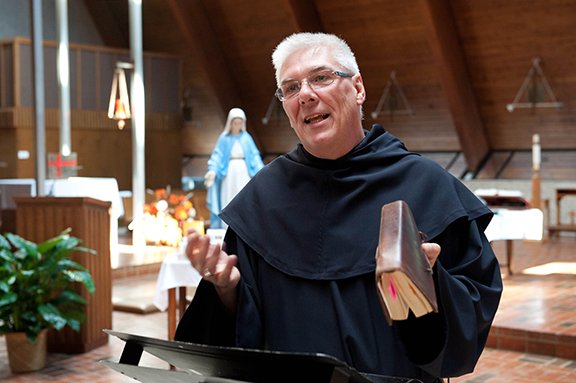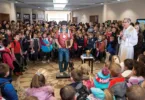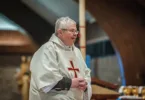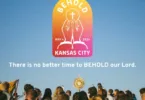
LEAVEN PHOTO BY JOE BOLLIG Father John Melnick, SSA, offers a reflection on the Second Vatican Council at a day of recollection for archdiocesan priests Nov. 8 at St. Patrick Parish, Kansas City, Kan.
Day gives priests a chance to “Learn it,” too, during year of faith
by Joe Bollig
joe@theleaven.org
KANSAS CITY, Kan. — Parishioners could tell by the tone of his voice that the venerable, old Irish priest at the little Nova Scotian parish was none too pleased.
The time was the early 1960s. New and exciting things — disturbing things, too — from the Second Vatican Council were arriving at the small, Canadian parish.
Father John Melnick, SSA, was a boy at the time, and it was his fate to serve Mass that Sunday when the pastor mounted the pulpit, took off his biretta topped with a green pom, and made his momentous announcement.
“In the name of the Father and the Son and the Holy Ghost, Amen,” the priest said. “I have a letter to be read from the bishop. It seems that we Catholics no longer believe in the Holy Ghost.”
Expressions of shock emanated from the pews.
The pastor read the bishop’s letter. The bishop wrote that the Second Vatican Council was moving the church to the use of the vernacular (or everyday) language in the Mass. Since the modern usage of the word “ghost” had negative connotations, the “in” word was now “spirit.”
The pastor shook his head and put away the letter.
“As long as I am the parish priest, I can guarantee you all that there will be no further changes at this parish,” he said. “In the name of Father, and of the Son and of the Holy GHOST — AMEN!”
And with that, the pastor slapped his biretta back on his head and climbed down from the pulpit.
Of course, there were further changes.
Change brought by the Second Vatican Council, as highlighted by this anecdote, was the topic of one of two reflections presented by Father John during the first of two days of recollection for archdiocesan priests. The first, on Nov. 8, was at St. Patrick Parish in Kansas City, Kan. The second will be in April.
Father Brian Schieber, archdiocesan vicar general for clergy, is the organizer of the days of recollection for priests.
“[The days] came about because Pope Benedict XVI, in his decree on the Year of Faith, asked all Catholics to study the documents of the Second Vatican Council and the Catechism [of the Catholic Church] during the Year of Faith,” he said.
“I thought [these days] would be an opportunity for priests to take a fresh look at the council documents,” Father Schieber continued. “It’s good to go back and study them anew. There are always graces and fruits if we respond to the pope’s invitation to do something like this.”
“I’m certainly no magisterial voice like the archbishop,” said Father Melnick, an Augustinian priest and director of campus ministries and religious studies at Donnelly College in Kansas City, Kan., in his introduction.
“I am a priest who has lived his life, just like you, in the shadow of the Second Vatican Council,” he said.
Pope John XXIII called for a council because he wanted to “care for souls in modern times,” said Father John. “[He wanted to] seek for clarity of thought and to increase spiritual riches in people’s lives.”
John XXIII was a fatherly and gentle man, said Father John, but was also very intelligent. He received some of the best education the church could offer and was formed in a “church culture.” He had a wonderful “transformative” spirit and a wider sense of the world than most churchmen.
That could get a person in trouble with the Holy Office.
Father John told the story of how — after Pope John XXIII’s election — the new pontiff asked to see his own personnel file. It said, “This priest is suspected of being a modernist.”
The pope pulled out his pen and angrily wrote, “I have NEVER been a modernist.” Later, the pope chuckled and said, “Well, it just goes to show you can get in trouble with the Holy Office and still be elected pope!”
Father John said there were four concepts that shaped the mind and pastoral ministry of Pope John XXIII: “convivenza,” “aggiornamento,” “pace e unità,” and “il senso del umorismo.”
Most people who know about the Second Vatican Council know about “aggiornamento” — which is Italian for bringing up to date, or seeing things with a new freshness or light.
The other three are important, too, however. “Convivenza” means everyone has a voice. “Pace e unità” means “peace and unity,” a reference to a tranquility of order that results from a respect for human rights. And finally, “il senso del umorismo ” means to make humor a way of living — to develop the ability to laugh and deal with the contradictions of life.
Pope John XXIII lived “il senso del umorismo” even to the moment of his death, said Father John. The pope’s sacristan, Bishop Canisius Van Lierde, OSA, didn’t have much actual pastoral experience, so the dying pope had to show him the correct way the anointing of the sick was done.
The last words of Pope John XXIII were, “My time on earth is drawing to a close. But Christ lives on and continues his work in the church. Souls, souls, ‘Ut omnes unum sint’ (‘That they may all be one’).”
“That is the spirit that generated what’s happened with the council,” said Father John. “It’s the spirit of a shepherd who was led by the Holy Spirit of God, who knows what human weakness is and strength is, knows what the faith of the church is, and the beauty and the power of the Gospel.”







What a wonderful story! Picturing the Pastor’s reaction, all in my mind, brings a smile to my face 🙂 I remember those days well, at our Parish. And, oh, how I missed the Latin Mass. The altar, with the railed kneeling bench to receive Holy Communion gone, as well as the Priests facing the East.
I did , however, like the Pontiff’s sense of humour, showing his humanity, while carrying out God’s work.
Alas, change in our time is inevitable. But the core beliefs remain the same. Thank you so much for this recollection, Father Melnick.